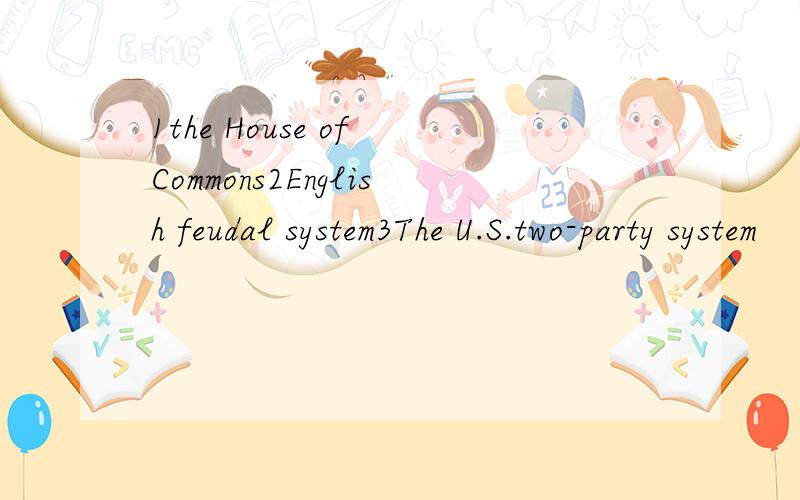1the House of Commons2English feudal system3The U.S.two-party system
来源:学生作业帮助网 编辑:作业帮 时间:2024/04/28 09:30:20

1the House of Commons2English feudal system3The U.S.two-party system
1the House of Commons
2English feudal system
3The U.S.two-party system
1the House of Commons2English feudal system3The U.S.two-party system
1the House of Commons
The House of Commons is the lower house of the Parliament of the United Kingdom, which also comprises the Sovereign and the House of Lords (the upper house). Both Commons and Lords meet in the Palace of Westminster. The Commons is a democratically elected body, consisting of 646 members, who are known as "Members of Parliament" (MPs). Members are elected through the first-past-the-post system by electoral districts known as constituencies. They hold their seats until Parliament is dissolved (a maximum of five years after the preceding election).
A House of Commons of England evolved at some point in England during the 14th century and, in practice, has been in continuous existence since, becoming the House of Commons of Great Britain after the political union with Scotland, and also, during the nineteenth century, of the United Kingdom of Great Britain and Ireland after the political union with Ireland. The House of Commons was originally far less powerful than the House of Lords, but today its legislative powers exceed those of the Lords. Under the Parliament Act 1911, the Lords' power to reject most legislative bills was reduced to a delaying power. Moreover, the Government is primarily responsible to the House of Commons; the Prime Minister stays in office only as long as he or she retains its support. Almost all government ministers are drawn from the House of Commons and, with one brief exception, all Prime Ministers since 1902.
The full, formal style and title of the House of Commons is The Honourable the Commons of the United Kingdom of Great Britain and Northern Ireland in Parliament assembled.
2 English feudal system
Feudalism is a decentralized sociopolitical structure in which a weak monarchy attempts to control the lands of the realm through reciprocal agreements with regional leaders.
The word feudalism was not a medieval term but an invention of 16th century French and English lawyers to describe certain traditional obligations between members of the warrior aristocracy.
Three primary elements characterized feudalism: lords, vassals, and fiefs; the group of feudalism can be seen in how these three elements fit together. A lord granted land (a fief) to his vassals. In exchange for the fief, the vassal would provide military service to the lord. The obligations and relations between lord, vassal and fief form the basis of feudalism.
3The U.S. two-party system
A two-party system is a form of party system where two major political parties dominate voting in nearly all elections, at every level. As a result, all, or nearly all, elected offices end up being held by candidates endorsed by one of the two major parties. Coalition governments occur only rarely in two-party systems.
Under, a two-party system, one of the two parties typically holds a plurality in the legislature (or a legislative house in a bicameral system), and is referred to as the majority party. The smaller party is referred to as the minority party. Two-party systems are most common in polities with plurality vote counting system ("first past the post") to prevent the problem of two similar candidates "splitting" the same voters.
Notable examples of countries with two-party systems include the United States and Jamaica. Though these countries are often thought of as being two-party states, other parties may have small but significant bases of support and have seen candidates elected to local or subnational office.
Generally, a two-party system becomes a dichotomous division of the political spectrum with an ostensibly right-wing and left-wing party: Tories vs. Labour in some Commonwealth countries, Republicans vs. Democrats in the United States, and so on.